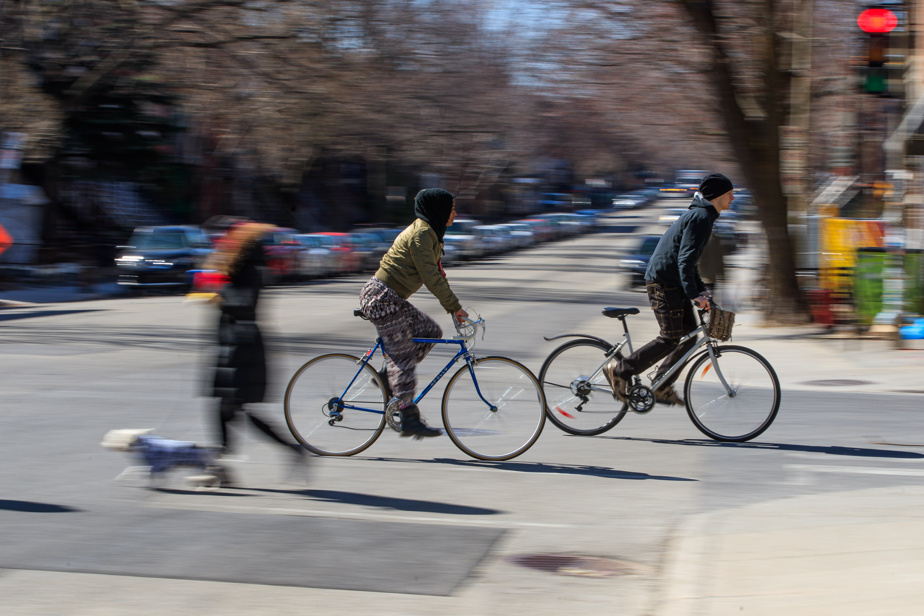A new road safety awareness campaign by the Sûreté du Québec (SQ) is causing controversy. The operation, which should last a week across the province, places the burden only on pedestrians and cyclists, obscuring any responsibility for drivers, deplore several organizations.
“Vulnerable users, like pedestrians, are required to adopt behaviors that promote their safety”, sums up the “National Concerted Operation Sharing the Road” campaign, which runs from April 28 to May 4.
“In 2021, just over 2,000 pedestrians were involved in collisions on the road network. It is essential that these users, who are vulnerable, also exercise caution by adopting simple behaviors, “writes the SQ in particular, providing eight prevention tips for pedestrians, four for cyclists, but none for motorists.
“We can’t believe it. It’s really shocking. It’s as if we were giving up and saying to ourselves that basically, motorists, we won’t be able to change them, ”says Magali Bebronne, director of programs at Vélo Québec.
The organization, which had been involved in certain discussions surrounding the campaign, says it slammed the door of it when it saw “the direction” that the Sûreté du Québec had decided to take a few days ago. Vélo Québec claims in particular to have sent several documents illustrating good practices to adopt for such a campaign, but is disappointed to see that these have not been used.
“Making a campaign about sharing the road by asking vulnerable road users to do more to ensure their own safety, without giving any advice to drivers, goes against everything that should be done to impute a real accountability to road users,” says Ms. Bebronne.
At Piétons Québec, general manager Sandrine Cabana-Degani agrees. “The message that emerges from this campaign is that the onus is solely on cyclists and pedestrians to ensure their own safety. This is contrary to the precautionary principle introduced in the Highway Safety Code in 2018, ”she insists.
“We should above all put energy into making heavy vehicle drivers understand that they have an increased responsibility for the safety of the most vulnerable,” insists Ms. Cabana-Degani.
The Équiterre organization also deplores the direction taken by the SQ in its campaign. “Well done for your release on sharing the road which is basically saying that pedestrians and cyclists are dangers to motorists. Give me a sign when you decide to come to the 21st century, ”said its director of government relations, Marc-André Viau, on Twitter on Thursday.
At the SQ, we refrain from taking any side whatsoever. “All road users also need to exercise caution, but it also involves the most vulnerable. It’s not negative. Everyone is just being told to be careful. You have to see it in a positive way, ”pleads Lieutenant Ann Mathieu on this subject.
“The message, basically, is that everyone can do their part in order to promote their safety and that of others,” insists Ms. Mathieu. She recalls in passing that “other communications” are frequently sent to “particularly target motorists” in terms of prevention. “It includes distraction, reckless driving, alcohol, drugs and so on. »
In a study published in 2016, the Société de l’assurance automobile du Québec (SAAQ) had clearly indicated that the main cause of pedestrian accidents was driver distraction in a study published in 2016. Indeed, distraction is to blame in 64% of collisions between a vehicle and a person on foot. In 68% of these cases, it was the driver who failed to pay attention, compared to 15% for the pedestrian (the responsibility is shared in 17% of cases).
According to the study, the speed of vehicles is a determining factor in the severity of collisions. Pedestrians have a 10% chance of dying if hit at 30 km/h, compared to 75% at 50 km/h. The SAAQ also noted that almost all pedestrian accidents (95%) occur in areas of 50 km/h or less.
Moreover, the campaign does not mention that pedestrian crossings are not respected by motorists in Quebec. On the contrary, the campaign believes it is the responsibility of pedestrians to “make eye contact with drivers”.
This is not the first time that a campaign of its kind has caused unease. Last summer, small signs from the Service de police de la Ville de Montréal (SPVM) were installed at 42 accident-prone intersections in Montreal, to invite pedestrians to “look on each side” and to be “watchful for vehicles who make turns”. Residents then considered the initiative “infantilizing”.

